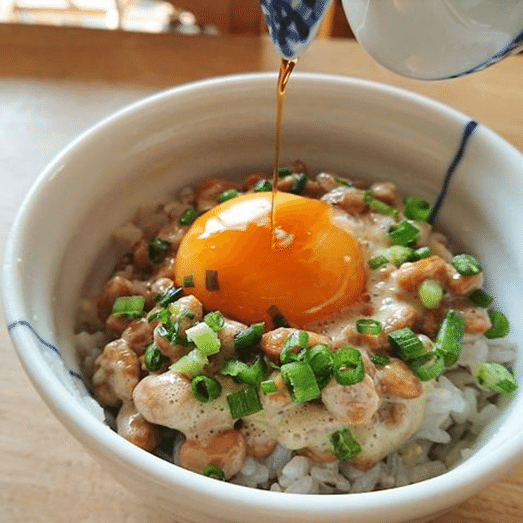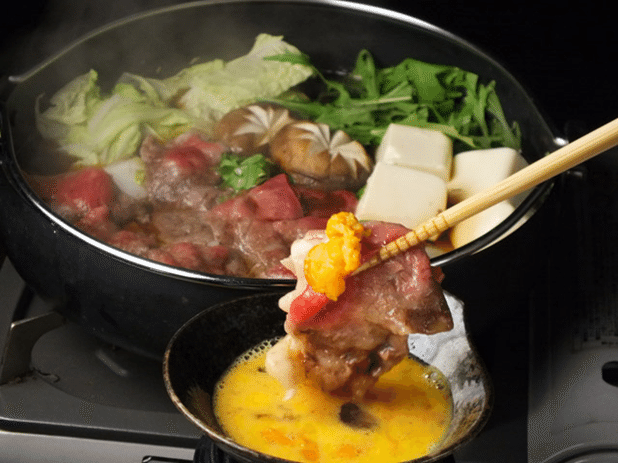
Introduction of "Washoku"
This article is a summary of Japanese food that we would like to introduce to people from other countries.
If you want to be considered familiar with Japan, you can read this article.
Washoku
Japanese cuisine was registered as World's intangible cultural heritage of UNESCO in 2013.
Foundation of "Washoku" is "Ichiju Sansai" style. Ichiju means one soup and Sansai means three side dishes.
Rice is the staple food of Japanese, so it will be always included in every Washoku meal.
A bowl of rice is placed at the left front of the diner, and a bowl of soup at the right front. The main dish is set in front of the soup, and one of the side dishes is set in front of the rice, with the other side dish set between the two.

Home cooked food
Raw egg on white rice
Raw egg is often eaten with soy sauce on white rice.
Natto
Natto is fermented soybeans. It has a particular smell and a slimy texture. It might look scary, but it is safe to eat.
Miso soup
The soup is made with miso and fish or seaweed stock. Miso is soybean paste.
You will typically find tofu and vegetables in the soup, but just about anything can go in it.
We grow up with miso soup, so it is our comfort food.
Nikujaga
This is a staple dish in Japanese households.
Meat and vegetables stew with sweetened soy sauce.

✅If you eat white rice with natto and raw egg, you are already Japanese!

Osechi
We eat "osechi-ryori" in celebration of the New Year in Japan.
It is traditional Japanese New Year’s dishes, whose ingredients are believed to bring good luck.
Black beans are eaten to encourage work and academic achievement.
Shrimp are eaten to pray for longevity, because their curved shape is like an old man.
Konbu rolls are eaten to wish for fertility and family prosperity.
Kazunoko is eaten to pray for the prosperity of descendants.
Kurikinton (mashed sweet potato with sweet chestnuts) raises money luck.
Sweet omelet is to wish to improve knowledge, because the shape resembles a scroll of reading material.

✅If you can explain the meaning of osechi ingredients, you are more Japanese than Japanese!
Sushi
Sushi is a mouthful of vinegared cooked rice topped with a slice of fish. You can eat sushi with your fingers if you want.

In Japanese sushi restaurants, California rolls are rarely seen.
There are two types of sushi restaurants.
1. Typical sushi restaurant
Sushi chefs make sushi right in front of you as you order and serve them fresh.
2. Conveyor-belt sushi bar
A casual bar where you can take your favorite right off the conveyor-belt as it goes around the restaurant. The price is different depending on the color and design of the plate. Even if the kind of sushi you want to eat doesn't come around, you can still order and have them make it.

When adding soy sauce to sushi, the correct way to eat it is to add soy sauce to the ingredients instead of the rice.
It's not a manner, but if you put it in your mouth with the ingredients down, it will be easier for the ingredients to hit your tongue, and you can enjoy the taste of sushi more deliciously.
✅If you eat sushi upside down, you are considered to be familiar with sushi!
Tempura
Tempura is seafood or vegetables that have covered in batter and fried in oil. The batter is made by dissolving flour and egg in water.
Tempura is eaten by dipping it into the tempura sauce or with a little salt. Adding grated daikon radish to the tempura sauce to make the flavor lighter.
Menu - Shrimp, Squid, Scallop, Conger eel, Japanese whiting, White fish, Eggplant, Lotus root, Shiitake mushroom, Pumpkin, Sweet potato, Shiso(Perilla), Okura, Shishito pepper, Mixed vegetables.

Basically, the light-tasting ingredients are placed in the foreground and the deep-tasting ingredients are placed in the back, so you should eat the tempura platter from the front.
This is because it is better to eat from the light-tasting ingredients.
✅If you eat tempura in order from the front one, you are considered to be familiar with tempura!
Ramen
Ramen is originally a Chinese food, but now we have our Ramen culture in Japan.
In Japan, slurping noodles is not bad manners, it's typical.
Local specialties of Ramen are found in many cities throuout Japan.
1. Iekei ramen - thick noodles in creamy pork bone and soy sauce soup.
2. Tokyo ramen - wavy noodles in light and clear soy sauce soup.
3. Hakata ramen - thin straight noodles in milky pork bone soup.
4. Sapporo ramen - thick chewy noodles in miso base soup.

✅If you can talk about ramen in each region and eat it with a slurping noise, you are already Japanese!
Soba and Udon
Buckwheat noodles are called "Soba" and white wheat noodles are called "Udon" in Japanese.
Soba is grey and looks a little spaghetti.
Udon is white and thicker than Soba.
we eat them in soup made from seaweed and fish stock.
Fried tofu, meat and deep-fried shrimp are often used as toppins.
In the summer, we dip cold noodles in a dipping sauce.

Sukiyaki
Ingredients such as thin slice of beef, tofu, mushrooms and vegetables are cooked in a pot with soy sauce, stock and sauger.
Dip them in a raw egg before eating and we have the leftover broth with udon.
All the ingredients are already seasoned in sukiyaki sauce, so you can eat them as they are (without soaking raw eggs).

Takoyaki and Okonomiyaki
Takoyaki
Chopped octopus is put into the batter, and then baked in the shape of little balls.
Okonomiyaki
It's like a Japanese pancake. The batter is made from flour, eggs and stock. We minced cabbage and seafood or meat into the batter and fly the mixture on a hotplate. At many Okonomiyaki restaurants, you do the pan-frying yourself on a hotplate attaced to the table.

この記事が気に入ったらサポートをしてみませんか?
